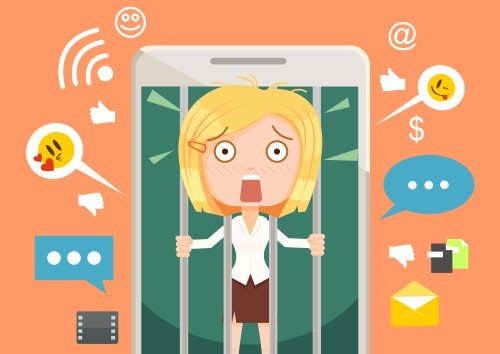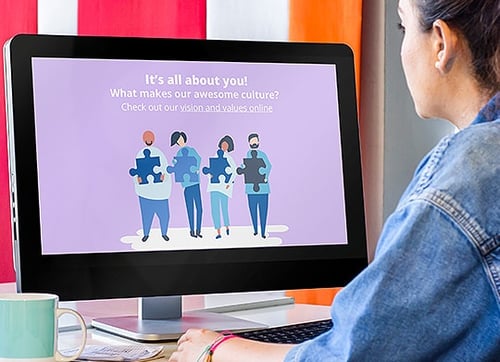
Imagine arriving at work to find robots sitting at every desk, tapping away at keyboards. Sounds like the plot of a movie. In fact, it is. It’s the world in I, Robot.
Fortunately, workplaces today don’t have androids in the office yet. But the spread of technology still exerts a huge influence. As the use of digital tools and virtual teams increases, maintaining positive culture in the workplace has become harder.
This has very real implications for businesses. Staff have never had faster, easier access to information. But many are overwhelmed by their digital capabilities. They struggle to disengage. Digital collaboration tools make it harder to create truly cohesive teams.
Building a strong culture is essential for business success – but how to achieve it in this environment? Regardless of where your organization is on the digital transformation journey, this is the information – and solutions – you need to know.
Cause and e-tech – The link between culture and digital workplaces
The importance of positive company culture is something everyone can agree on. Not only does it improve employee engagement and satisfaction, it boosts business performance. Companies with strong cultures saw a 400% increase in revenue growth.
But how can we prove the link between company culture and digital workplaces? How do the technology-led workplaces of today impact on that workplace’s culture?
As more and more organizations embark on digital transformation projects, the relationship with culture is being revealed. Almost half of organizations believe that company culture is the biggest contributor to effective digital transformation.
Poor culture is cause for concern at the highest levels of management. A 2018 survey found that 46% of CIOs believed poor culture was the biggest barrier to a successful digital business.
Why is this? What causes culture to suffer in digital-dominated workplaces?

Digital downtime – Why does culture suffer in digital workplaces?
Since technology offers so many benefits, why should it undermine workplace culture? Some of the reasons are directly related to the technology. Others are workplace behavior changes unwittingly introduced as a consequence.
Digital transformation itself is often the root cause. By their nature, these initiatives are focused on technology rather than people. Automation, digitization, systems and infrastructure – they’re all technical improvements designed to improve process and delivery. Focusing on what people need, beyond just digital capabilities, is key – but often overlooked.
Technologies introduced for security or convenience often don’t encourage culture. Webcams, ID card-readers, biotechnologies – all have a dehumanizing influence, however unintended.
Mobile digital technology is blurring the line between work life and personal life. Employees are no longer able to disconnect at home time. Checking emails, responding to messages and being ‘on call’ are commonplace. In many workplaces, they’re expected. This lack of defined work and personal time is increasing stress, encouraging cyberslacking and eroding culture.
Even online collaboration tools, touted as a way to facilitate teamwork, are largely impersonal. They may enable fast exchanges of information (or just pointless conversation), but they don’t support the deeper, richer discussions that build culture.
Technology has brought about a change in the traditional team model. Where previously staff would be sitting in pods with colleagues, today’s teams are increasingly virtual rather than physical. They’re fragmented, remotely-based and geographically-dispersed. Fostering healthy interpersonal relationships and a positive culture are infinitely harder with virtual teams.

Techs happy – How to improve your workplace culture
Since a strong workplace culture is desirable, but digital developments are undermining this, what can be done? How can culture be improved without risking technical progress? These tactics will help take your teams from tech savvy to tech happy.
1. Personalize your projects – don’t make people an afterthought in your next digital project. Personalize the journey by making it meaningful to staff. How will the project affect them at each stage? How can the contributions of individuals be highlighted?
Take every opportunity to involve staff throughout. Get input on initial requirements, feedback on concepts or pre-release testing. The key to building positive culture while rolling out successful digital developments is to put people and processes above technology.
2. Promote tangible benefits – make sure the value of new digital tools is clear. Focusing on the benefits reduces mistrust about the change. In what ways will it improve working conditions? Maybe it will provide opportunities for more flexible working arrangements or streamline processes to remove tedious tasks. Don’t be shy in keeping WIIFM top-of-mind – shout it from the rooftops!
3. Focus on achievement – it’s easy to get bogged down in technical details, especially when it’s information staff need to be aware of. But that’s not the sort of content that drives culture.
Instead, spend equal amounts of time on achievement messaging. What key milestones have been achieved? Which employees have delivered outstanding performance? What amazing result has been attained? Promoting achievements builds a sense of success and fulfillment – both personal and for the team.
This is where internal communications can truly shine. Use a range of high visibility internal communication channels to spread the word about successes.

4. Don’t make digital your default – when you need to collaborate with team members, don’t immediately jump to a digital solution. Consider what could be done in-person. This interaction is important in breaking down silos and produces more satisfying results.
Frank discussions are easier, emotional responses clearer and outcomes better understood. Encourage face-to-face meetings to build relationships and improve culture.
5. Invest in training – not all employees feel comfortable with digital tools. Some will resent the changes, and many will need ongoing support. Investing in proper training is helpful to overcome resistance, foster a positive mindset and support personal growth.
Make training a key consideration in any digital workplace strategy so that employees develop the necessary skills to keep up in a dynamic environment.
6. Build a pleasurable workplace – most of us are destined to spend half our lives at work. As much as possible this must be somewhere we desire to be, not dread. However much technology has pervaded, the goal is to build somewhere that’s both pleasurable and productive.
This includes being human-centered, reassessing the nature of teamwork and other tactics to build digital workplaces fit for the future. Create the conditions for a positive workplace culture and you’ll ensure staff stay along for the ride.
Encouraging good company culture is harder in a digital world. But it can be achieved with the right tactics and the right attitudes - which will keep your staff happy and help the business grow. Androids need not apply.


